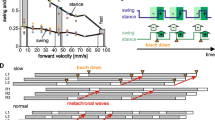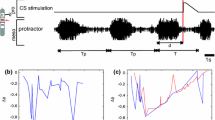Summary
Considerable information is now available on the neural organization of the escape system of the American cockroach. To relate these data to the behavior, we need detailed information on the movements made at the principle leg joints that produce the turn. We used motion analysis of high speed video records to acquire such information. Records from both free ranging and tethered animals were analyzed.
-
1.
We analyzed individual joint movements using a tethered preparation. Stimuli from 4 different angles around the animal were used. For all wind angles, the femur-tibia (FT) joint on the mesothoracic leg that is ipsilateral to the wind source extended while the contralateral mesothoracic FT joint flexed. This moved both of these legs laterally toward the wind source. In freely moving animals the FT movements provide forces that turn the animal away from the wind source.
-
2.
The ipsilateral mesothoracic coxa-femur (CF) joint extended for all wind angles. The contralateral mesothoracic CF joint extended in response to most winds from the rear, but switched to flexion in response to wind from the side and front. As a result of these joint movements, rear wind resulted in rearward movements of the contralateral mesothoracic leg, while side and front wind resulted in more forward movements of that leg.
-
3.
The CF and FT joints for both ipsilateral and contralateral metathoracic legs extended to wind from the rear and switched to flexion as the wind was placed at more anterior positions around the animal. In freely moving animals, extension of these joints would push the animal forward. Flexion would pull the animal backward.
-
4.
Several of the joints showed correlations between rate of movement and initial joint angle. That is, joints that were already flexed at the onset of stimulation tended to move at a faster rate to a final position than joints that started at a more extended position.
-
5.
Metathoracic FT and CF joints showed a high degree of positive correlation during the escape movements. Indeed, many curves showing movement of metathoracic FT and CF joints with time were virtually identical.
Similar content being viewed by others
Abbreviations
- CF :
-
coxa-femur
- FT :
-
femur-tibia
- TC :
-
thorax-coxal joints
- T 1 :
-
prothoracic
- T 2 :
-
mesothoracic
- T 3 :
-
metathoracic segments
References
Burrows M (1980) The controls of sets of motoneurones by local interneurones in the locust. J Physiol 298:213–233
Burrows M (1989) Processing of mechanosensory signals in local reflex pathways of the locust. J Exp Biol 146:209–227
Burrows M, Laurent GJ, Field LH (1988) Proprioceptive inputs to nonspiking local interneurons contribute to local reflexes of a locust hindleg. J Neurosci 8:3085–3093
Camhi JM, Levy A (1988) Organization of a complex motor act: Fixed and variable components of the cockroach escape behavior. J Comp Physiol A 163:317–328
Camhi JM, Tom W (1978) The escape behavior of the cockroach Periplaneta americana. I. Turning response to wind puffs. J Comp Physiol 128:193–201
Camhi JM, Tom W, Volman S (1978) The escape behavior of the cockroach Periplaneta americana. II. Detection of natural predators by air displacement. J Comp Physiol 128:203–212
Daley DL, Camhi JM (1988) Connectivity pattern of the cercal-to-giant interneuron system of the American cockroach. J Neurophysiol 60:1350–1368
Delcomyn F (1971) The locomotion of the cockroach Periplaneta americana. J Exp Biol 54:443–452
Eaton RC (1984) Neural mechanisms of startle behavior. Plenum Press, New York, NY
Full RJ, Blickhan R, Ting LH (1991) Leg design in hexapedal runners. J Exp Biol 158:369–390
Georgopoulos AP, Lurito JT, Petrides M, Schwartz AB, Massey JT (1989) Mental rotation of the neuronal population vector. Science 243:234–236
Land MF (1972) Stepping movements made by jumping spiders during turns mediated by the lateral eyes. J Exp Biol 57:15–40
Laurent G, Richard D (1986) The organization and role during locomotion of the proximal musculature of the cricket foreleg. I. Anatomy and innervation. J Exp Biol 123:255–283
Murphey RK (1971) Motor control of orientation to prey by the waterstrider, Gerris remigis. Z Vergl Physiol 72:150–167
Murrain MP, Ritzmann RE (1988) Analysis of proprioceptive inputs to DPG interneurons in the cockroach. J Neurobiol 19:552–570
Nicklaus R (1965) Die Erregung einzelner Fadenhaare von Periplaneta americana in Abhängigkeit von der Grösse und Richtung der Auslenkung. Z Vergl Physiol 50:331–362
Parnas I, Dagan D (1971) Functional organization of giant axons in the central nervous system of insects: New aspects. In: Beament JWL, Treherne J, Wigglesworth VB (eds) Advances in insect physiology. Academic Press, New York, pp 95–143
Pearson KG, Wong RKS, Fourtner CR (1976) Connexions between hair-plate afferents and motoneurones in the cockroach leg. J Exp Biol 64:251–266
Ritzmann RE (1984) The cockroach escape response. In: Eaton RC (ed) Neural mechanisms of startle behavior. Plenum, New York, pp 93–131
Ritzmann RE, Pollack AJ (1986) Identification of thoracic interneurons that mediate giant interneuron-to-motor pathways in the cockroach. J Comp Physiol A 159:639–654
Ritzmann RE, Pollack AJ (1988) Wind activated thoracic interneurons of the cockroach: II. Patterns of connection from ventral giant interneurons. J Neurobiol 19:589–611
Ritzmann RE, Pollack AJ (1990) Parallel motor pathways from thoracic interneurons of the ventral giant interneuron system of the cockroach, Periplaneta americana. J Neurobiol 21:1219–1235
Spira ME, Parnas I, Bergmann F (1969) Histological and electrophysiological studies on the giant axons of the cockroach Periplaneta americana. J Exp Biol 50:629–634
Westin J, Ritzmann RE, Goddard DJ (1988) Wind activated thoracic interneurons of the cockroach: I. Responses to controlled wind stimulation. J Neurobiol 19:573–588
Author information
Authors and Affiliations
Rights and permissions
About this article
Cite this article
Nye, S.W., Ritzmann, R.E. Motion analysis of leg joints associated with escape turns of the cockroach, Periplaneta americana . J Comp Physiol A 171, 183–194 (1992). https://doi.org/10.1007/BF00188926
Accepted:
Issue Date:
DOI: https://doi.org/10.1007/BF00188926




